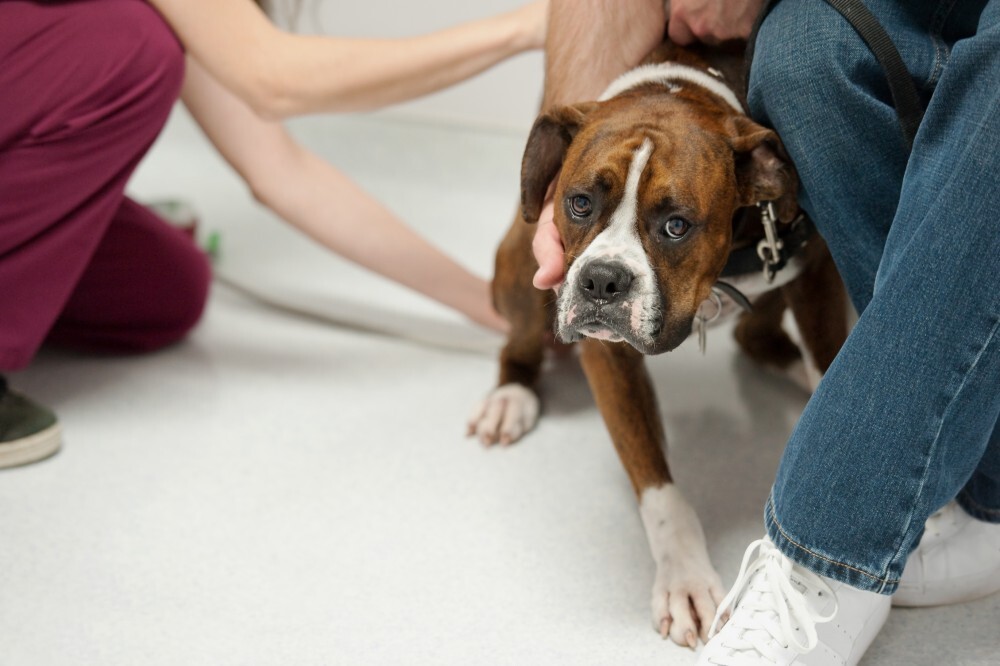Do you ever wonder what a visit to a vet clinic is like from a dog’s perspective?
If we vets tried to imagine what this would be like, it might help us to empathise with our patients, and perhaps we might adjust our routines slightly to make their experiences more enjoyable.
There are two major differences between the way that animals and humans experience life. First, our sense perception, and secondly, our cognition.
The structure of the brain makes this obvious: dogs have a far larger olfactory lobe (dealing with the processing of smells), and humans have a much bigger frontal lobe (allowing us to think and contemplate in more detail).
The increased sense perception of dogs means that when they arrive at the vet, they’ll be confronted with an array of smells and sounds that pass us humans by. For them, the air will be filled with traces of the other animals that have passed through that day (and perhaps the previous day). And perhaps they detect more than just the presence of other animals: there may be scents that reflect fear and anxiety.
Dogs experience the clinic at floor level, with their nose close to the ground, and despite our best efforts to clean up any piddles left by earlier visitors, they may well pick up residual evidence of other dogs marking their territory. This tsunami of odours must make a vet clinic an intimidating place for a dog: where else would they encounter such a patchwork of a mixture of evidence of other animals.
Their sound sensitivity must add to their stress: as well as the immediate cacophony of that big dog barking as they arrive, along with that grumpy cat hissing at them, they may hear the occasional faint whimper, howl and yelp from dogs in consulting and behind-the-scenes rooms, reacting as injections are given, dressings are applied and temperatures are taken.
The differing cognition of dogs will also have an impact. We know from dynamic brain imaging studies that dogs share similar parts of the brain to ourselves when it comes to feelings and moods, such as fear, anxiety and emotional memories. It’s no wonder that many dogs tremble and shake at the vet: they recall previous encounters when they were feeling unwell, and they were taken to this strange place, lifted onto a table where they were poked, prodded and injected. They aren’t manhandled like this at any other time in their lives, and they cannot make the cognitive connection between visiting the vet and receiving treatment that makes them feel better. We shouldn’t be surprised that they often have a negative memory of their visits to the vet.
So how can we improve a dog’s experience at the vet clinic?
First, their sensory experience. We need to keep our clinics impeccably clean, using appropriate enzymatic cleaners so that every trace of previous animals’ scents is removed. We might consider using dog pheromone diffusers to instil calming pheromones into the atmosphere. We need to have careful clinic design so that sounds from animals in hospital treatment areas (such as the involuntary whining of a dog coming around from an anaesthetic) are not audible in the waiting room. And we can create positive sensory experiences by giving dogs tasty treats and plentiful praise after consultations.
Second, their cognitive experience. We should aim to make our clinics fear-free zones, where dogs have friendly, pleasant encounters. We need to keep combative animals away from one another, with separate waiting areas for dogs and cats, as well as keeping boisterous animals away from the more anxious ones. We should be aware at all times of a dog’s mood: if an animal growls or snaps, we need to remember that this could be from fear, and we should address the issue accordingly, rather than moving straight to the harsh restraint methods of muzzle and dog catcher pole.
We should use medication, such as sedation and anti-anxiety drugs, so that animal are less stressed by their experiences, and perhaps so that they don’t have such strong memories of the inevitable negative aspects such as injections and delicate examinations. And we should encourage owners to bring their pets along for simple social visits to the vet, such as when they are buying food or medication. If dogs have regular visits where nothing happens to them other than being given praise and treats by friendly receptionist staff, they’ll soon learn to love going to the vet.
Just as dentists aim for pain-free service for humans, we vets need to provide fear-free visits for our patients. If we can do that, we’ll start to have more relaxed patients who will be far happier to see us.


